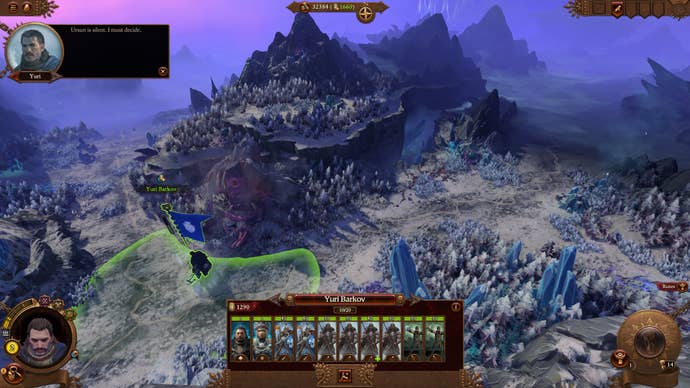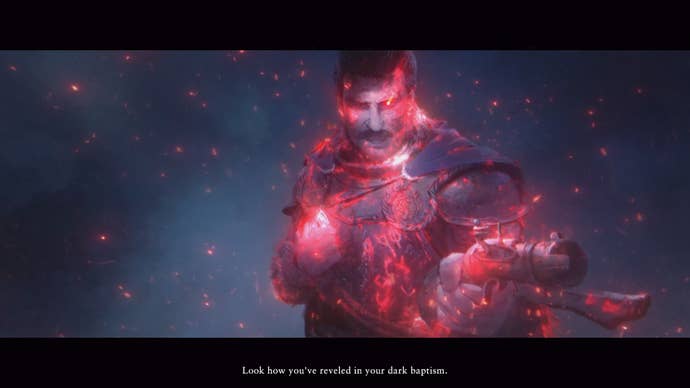Total War: Warhammer 3 review – Embrace your demons, and everyone else’s
Total War: Warhammer 3 is a robust and incredibly detailed strategy game that sometimes falls over itself.
Some embrace their faith when the gods fall silent, believing it a test or perhaps condemnation of their unworthiness. Others seek knowledge. Yuri of the Kislev sought to find and free his people’s sacred bear, Ursun, after six years of permanent winter and despair. When he found the object of his people’s adoration, Yuri acted without hesitation – and murdered him, absorbing the power of Chaos, transforming into a demon, and plunging the world into war.
Total War: Warhammer 3 isn’t about this prince, though, or even the fatally wounded Ursun whose dying roar sent a wave of magical destruction across the continents. It’s about the Chaos itself and the opportunities it opens for the world’s factions to pursue their own goals – to the benefit or ruination of everyone else. Warhammer 3 might not innovate as much as it could in some areas, but it’s still one of the richest strategy experiences around.
Yuri’s act of heresy against his beloved god is the catalyst that gives life to Warhammer 3, though not in the way you might initially think. After the prologue, a seemingly minor character comes to the fore: an unlucky old man bound to the Tome of Fates, a book that has the answer to every question for everyone except him. He’s determined to sever the book’s hold on him. A drop of Ursun’s blood is just what he needs, and the old man will go to any length imaginable to break his bonds and profit from the book.
The old man slots himself in as magical advisor – and convenient tutorial giver – to each faction in a bid to get Ursun’s blood by helping them realize their own goals. Choosing the recommended starter campaign, for example, sees the old man act as advisor to Kylas, Yuri’s demon form, as he tries conquering the gods of Chaos and setting himself up as the most powerful deity. The old man is equally happy trying to restore harmony in the far east if it means getting what he wants, though.
It’s an appropriately chaotic narrative background and a dynamic, making it feel different from previous Warhammer games (and even most strategy games). There are no heroes in Warhammer 3, not in the usual sense at least. The Kislev might seek to repair Yuri’s damage, but they enforce outdated and oppressive beliefs on their people. Sure, they don’t spread poison and gain power by offering people’s skulls as tribute, as other factions do, but they’re hardly an admirable bunch.

These disparate stories unfold in campaign mode, Warhammer 3’s grand strategy segments, akin to a fantastical version of Risk and Civilization. On the Risk side, you’re building an ever-increasing collection of conquered settlements and solidifying your presence in enemy territories, fending off attacks and making strategic alliances to avoid conflict when possible. You also need to balance your investments in these settlements, carefully choosing between economic development and the military power you need for the next siege. There’s a staggering amount to balance and consider in a given turn. It rarely feels overwhelming, though, and nothing compares to the feeling of witnessing a long-term plan bear fruit.
The objectives that appear on the campaign map help tell your faction’s story, and while your leader must make significant decisions at key points, it’s never quite on the level of something such as Frostpunk. Decisions determine what equipment or skill you might get and have little story significance, which is a slight disappointment considering how Warhammer III frames some of the choices you face along the way.
Campaign and the various stories are engrossing nonetheless and feel more energetic and innovative thanks to the stronger sense of purpose in each faction’s goals. Everyone wanted the same thing in Warhammer II: control of the Vortex. In Warhammer III, Ursun is often just a means to an end – a convenient experiment for one group or a witness to an event of divine importance for another. It’s a subtle reminder that one culture’s values and traditions have little bearing on another, and it influences your faction’s campaign goals as well.

Laying siege and making war still comprise campaign mode’s fundamentals, but how you approach them changes drastically depending on your faction and keeps Warhammer III absorbing even for longtime fans. The new Cathay faction, for example, needs to quell internal rebellion before challenging the forces of Chaos. Every choice affects the balance of harmony in the nation’s, admittedly stereotypical, guiding system of yin and yang, and disrupting that balance has serious consequences for your forces.
Other factions are slightly less innovative, but still fun to play. Take the Nurgle faction. Their leader, what amounts to a sentient and evil phlegm blob, wishes only to spread pestilence around the world as a gift to humanity. The Nurgle are a bit too functionally similar to the Vampire pirates of previous games, including the ability to summon units from the ether and drawing power from the level of corruption nearby. However, they do get unique poison abilities on the battlefield, so it’s not purely a reskin of the same faction.
Warhammer 3’s deep combat strategy is built around both careful resource and squad management and using the map layout to your advantage. Flanking enemy units is key, not just because it strikes a weak spot, but because demoralizing foes increases their chance of surrender – and the same applies to your forces. Granted, Warframe III battles still devolve into scenarios of “throw a thousand soldiers at the enemy until they die” as most real-time strategy games do, but overall it’s a much smarter and more refined take on the genre.
Unit variety and selection differs depending on faction, though not quite so much as you might think. The Kislev’s elemental bears have a clear power advantage over the lithe snow leopard soldiers, as do your demons wielding two-handed weapons. The difference between archers and the unique pistol wielding ranged units is less apparent outside the combat preview that says when one unit type is better matched against a foe than another. The sameness is even more noticeable with the demon factions, at least during the first half of a campaign, who often just get different colors of the same unit types.
Some of the usual real-time strategy issues also rear their heads. Units who defeat their target often stand around idle until you direct them again, even if there’s another enemy squad nearby, and pathing sometimes short circuits and sends groups in the completely opposite direction. Warhammer III’s maps could have made better use of the game’s more nuanced tactics, such as using cover and creating bottlenecks. Pulling off a successful diversion and obliterating an unsuspecting enemy force with a flanking maneuver is incredibly satisfying, though a few too many maps are featureless and don’t allow for this kind of planning.
Unit and map variety may be slightly underwhelming, but heroes, lords, and their powers help make up for it. Hero units have an impressive stable of skills at their disposal, and using them effectively often requires an intricate plan. Triggering a buff or using an area-of-effect skill at the right moment can push your army to victory or successfully debilitate your foe, allowing for a tactical retreat and regrouping.

These units have special powers in campaign mode as well, ranging from increasing your productivity to sometimes winning a battle before it even begins. Kislev’s Frost Maiden was a personal favorite, with her skullduggery helping weaken settlement defenses and even giving you a chance to kill enemy heroes without a full-scale battle.
Warhammer 3 is, frankly, an incredible package. It somehow manages to deliver multiple unique and satisfying campaigns, mostly without sacrificing their quality and depth in the process. Campaign and combat are expertly balanced – demanding but fair – with enough variety to make playing more than one faction worthwhile. More variety would be welcome in both faction characteristics and map design, but Warhammer 3 is still one of the most gratifying strategy games in recent years.



